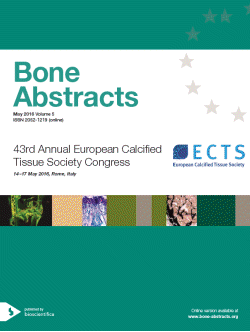
43rd Annual European Calcified Tissue Society Congress
Rome,
Italy
14 May 2016 - 17 May 2016

Cancer and Bone Oral Communications
Oral Communications
ba0005cabs.oc1.1 | Oral Communications | ECTS2016
Secreted YB-1 (Y-box binding protein 1) as a biomarker of bone disease progression in patients with breast cancer and bone metastases
Bettencourt Maria , Ferreira Arlindo , Alho Irina , Lucia Costa Ana , Sousa Ana Rita , Mansinho Andre , Abreu Catarina , Pulido Catarina , Macedo Daniela , Vendrell Ines , Pacheco Teresa , Costa Luis , Casimiro Sandra
ba0005cabs.oc1.2 | Oral Communications | ECTS2016
Bone and metabolic parameters are associated with overall survival in patients with bone metastases from adenocarcinoma lung cancer: the POUMOS study
Confavreux Cyrille B. , Chambard Lauriane , Ollier Edouard , Brevet Marie , Duboeuf Francois , Rousseau Jean-Charles , Pialat Jean-Baptiste , Wegrzyn Julien , Tescaru Agnes , Szulc Pawel , Carlier Marie-Christine , Girard Nicolas , Clezardin Philippe
ba0005cabs.oc1.3 | Oral Communications | ECTS2016
Blocking IL-1R signalling inhibits breast cancer growth and bone metastases by altering the tumour microenvironment
Bradbury Steven , Rennicks Sarah , Evans Alyson , del Carmen Basitdas Mary , Holen Ingunn , Ottewell Penelope
ba0005cabs.oc2.1 | Oral Communications | ECTS2016
Prostate cancer microRNAs in extracellular vesicles stimulate osteoclastogenesis
Bijnsdorp Irene , Mulder Jorn , Geldof Albert , Bakker Astrid , de Vries Teun , van Moorselaar Jeroen
ba0005cabs.oc2.2 | Oral Communications | ECTS2016
Integrin α5 is an independent prognosis factor and a potential therapeutic target for breast cancer bone metastasis
Pantano Francesco , Croset Martine , Driouch Keltouma , Bonnelye Edith , Bednarz-Knoll Natalia , Hong Saw-See , Iuliani Michele , Fioramonti Marco , Santini Daniele , Tonini Giuseppe , Pantel Klaus , Clezardin Philippe
ba0005cabs.oc2.3 | Oral Communications | ECTS2016
Cancer cell homing to the bone marrow is modulated by the mesenchymal stromal cell
Rossnagl Stephanie , Nakchbandi Inaam
ba0005cabs.oc2.4 | Oral Communications | ECTS2016
Peripheral tumour re-growth following combination therapy – role of the bone microenvironment
Haider Marie-Therese , Ottewell Penelope D. , Brown Nicola J. , Lefley Diane V. , Holen Ingunn
ba0005cabs.oc2.5 | Oral Communications | ECTS2016
Inhibition of BMP signalling reduces bone destruction and impacts niche maintenance in a mouse model of multiple myeloma
Gooding Sarah , Webb Siobhan , Olechnowicz Sam , Lwin Seint , Armitage Andrew , Ramasamy Karthik , Drakesmith Hal , Edwards Claire
ba0005cabs.oc3.1 | Oral Communications | ECTS2016
Blockade of C5aR impairs tumor-induced osteoclastogenesis preventing bone metastasis colonization in lung cancer
Ajona Daniel , Zandueta Carolina , Corrales Leticia , Pajares Maria J. , Martinez-Terroba Elena , Perurena Naiara , Montuenga Luis M. , Pio Ruben , Lecanda Fernando
ba0005cabs.oc3.2 | Oral Communications | ECTS2016
Osteoblasts inhibit the immune response against cancer
Rossnagl Stephanie , Kraft Sabrina , Sens Carla , Nakchbandi Inaam
ba0005cabs.oc3.3 | Oral Communications | ECTS2016
Visualizing the tumor immunity in living bone marrow by intravital 2-photon imaging
Yamashita Erika , Mizuno Hiroki , Ishii Masaru
ba0005cabs.oc3.4 | Oral Communications | ECTS2016
Anti-sclerostin treatment prevents multiple myeloma bone disease and reduces tumour burden
McDonald Michelle , Reagan Michaela , Terry Rachael , Pettitt Jessica , Le Lawrence , Mohanty Sindhu , Kramer Ina , Kneissel Michaela , Brooks Daniel , Cheng Tegan , Little David , Bouxsein Mary , Rosen Cliff , Ghobrial Irene , Croucher Peter
ba0005cabs.oc3.5 | Oral Communications | ECTS2016
Targeting skeletal metastatic breast cancer with bisphosphonic matrix metalloproteinase-2 inhibitors
Tauro Marilena , Laghezza Antonio , Paolo Tortorella , Lynch Conor
ba0005cabs.oc4.1 | Oral Communications | ECTS2016
Muscle dysfunction in immune competent mice with osteolytic breast cancer in bone is associated with skeletal muscle oxidation of RyR1
Regan Jenna , Waning David , Mohammad Khalid , Mikesell Carter , Reiken Steven , Marks Andrew , Guise Theresa
ba0005cabs.oc4.2 | Oral Communications | ECTS2016
Bisphosphonates prevent osteolysis and muscle weakness in aromatase inhibitor-treated mice with breast cancer bone metastases
Wright Laura , Harhash Ahmed , Waning David , Mohammad Khalid , Marks Andrew , Guise Theresa
ba0005cabs.oc4.3 | Oral Communications | ECTS2016
In vitro mechanotransduction of osteosarcoma cells
Coughlin Thomas R. , Gadi Abhilash , Mansukhani Alka , Kennedy Oran D.
ba0005cabs.oc4.4 | Oral Communications | ECTS2016
3D tissue engineered constructs for modeling tumor-induced bone disease
Dadwal Ushashi , Guo Ruijing , Lu Sichang , Vanderburgh Joseph , Merkel Alyssa , Kwakwa Kristin , Guelcher Scott , Sterling Julie
ba0005cabs.oc4.5 | Oral Communications | ECTS2016
New models of breast and lung cancer bone metastases for preclinical efficacy testing
Suominen Mari I. , Hagemann Urs B. , Konkol Yvonne , Bernoulli Jenni , Fagerlund Katja M. , Bjerke Roger M. , Karlsson Jenny , Halleen Jussi M. , Cuthbertson Alan



